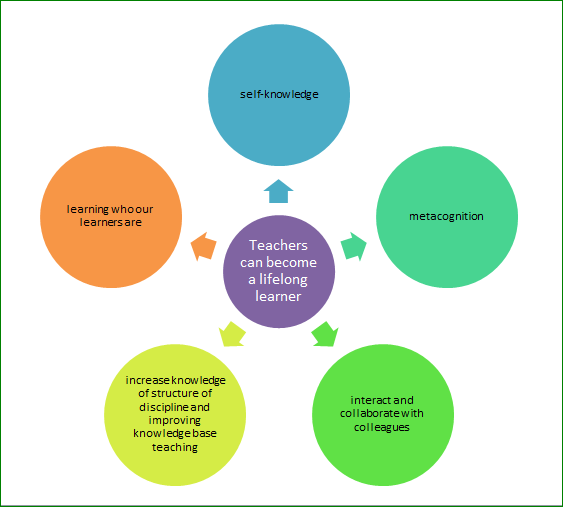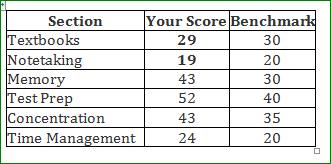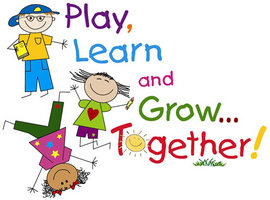A. WORKING WITH DIVERSE LEARNERS

Students differ in a multitude of ways, both individually and as groups. Individually, for example, students have a preferred learning style. Learning style is the students preferred ways of learning. The diagram below shows the types and characteristics of learning styles.

Students also have preferred cognitive or thinking styles. Cognitive styles are typical ways of perceiving and remembering information, and typical ways of solving problems and making decisions (Zhang & Sternberg, 2006).
- Cognitive style is a usually described as a personality dimension which influences attitudes, values, and social interaction.
- If a student has a cognitive style that is similar to that of his/her teacher, the chances are improved that the student will have a more positive learning experience. Likewise, team members with similar cognitive styles likely feel more positive about their participation with the team.
- Types of cognitive styles:
- Field independence versus Field Dependence. This refers to a tendency to approach the environment in an analytical way.
- Field-independent learner can distinguish figures as discrete from their background or can separate details from the surrounding context. They learn more effectively under conditions of intrinsic motivation like self-study and are influenced less by social reinforcement. They rely less on others or teachers for support. Useful classroom activities include extensive reading and writing, independent study of which learners can carry out alone (individualized learning). They also prefer highly analytical fields of study like math and science.
- On the other hand, field-dependent learner cannot distinguish detail from other information around it. They tend to work better in groups as they are good in interpersonal relationships. Useful classroom activities include discussion of what they know about the topic, predicting content, or looking at and listening to related materials. They prefer open-ended fields of study like history and literature.
- Reflection versus Impulsivity. This refers to the individual consistencies in the speed and adequacy with which alternative hypotheses are formed and responses made.
- Impulsive cognitive learner reacts quickly but as a result makes comparatively more errors while Reflective cognitive learner reacts more slowly and therefore makes fewer errors.
Ways to handle learning and cognitive styles:
There are two major ways to use knowledge of students’ cognitive styles (Pritchard, 2005). First, is to build on students’ existing style strengths and preferences and second, is to encourage more balance in cognitive styles for students who need it. It is good to support students’ preferred learning strategies where possible and appropriate, but neither necessary nor desirable to do so all of the time (Loo, 2004; Stahl, 2002).
Other ways:
The 4MAT framework based on the work of Dr. Bernice McCarthy which suggests 4 learning modes (Analytic, Imaginative, Common Sense, and Dynamic) has been widely applied in education (see http://www.aboutlearning.com).

- McCarthy developed the 4Mat System of instruction for Kolb’s learning styles. This system moves through Kolb’s learning cycle in sequence, beginning with the Type 1 quadrant, and teaches to all four learning styles. She theorizes that the natural learning progression starts with the instruction answering, in sequence, the questions that appeal to each major learning style: Why? What? How? And If?
The learning styles framework developed by Dunn & Dunn (1999) (see http://www.ilsa-learning-styles.com/Learning+Styles/The+Dunn+and+Dunn+Learning+Styles+Model.html) seems to be useful in terms of creating teacher awareness of individual differences in learning.

Similarly, learners have unique profiles or multiple intelligence (MI) or competence that affect how and what they learn most successfully. One of the most prominent of these models is Howard Gardner’s theory of multiple intelligences (Gardner, 1983, 2003).

He proposes that there are eight different forms of intelligence, each of which functions independently of the others. His model shows that there are more than one way to be ‘smart’ and therefore suggests the importance of diversifying instruction in order to honor and respond to students diversity of talents and abilities. Also, teachers need to accommodate the gifted learners either through acceleration, enrichment or combination of both and to observe, get to know the learners unique characteristics and offer activities and supports based on that knowledge. In the case of exceptionalities, teachers must understand that students disability might affect their learning hence teachers need to make instructional adjustments for that learner to be successful.
Good teaching considers learners varied learning styles and learner’s multiple intelligence. It is imperative on our part to possess a repertoire of teaching and testing strategies and techniques to reach a full range of students with varied learning styles and multiple intelligence
Aside from individual diversity, learners also differ in gender roles.

As a teacher, it is our responsibility to promote gender equality in the classroom. We can do this by giving all learners equal opportunities to succeed in their learning. We can also give them more encouragement to be engaged in the class or restructure the class in ways that promote greater interaction from a wider number of learners. Another way is to call more quiet learners to participate or place them in groups that they feel more comfortable to collaborate. Lastly, give learners equal attention and specific feedback.
Learners likewise differ in:
Culture: Teachers must understand that Instruction might be confusing to learners if their cultural experiences or background knowledge are different from ours. Use this understanding to inform our teaching and help learners feel welcome, cared about respected and valued in the class so they can be more engaged and motivated to learn.

Linguistics: Teachers must understand that mastering academic content might be difficult for learners who are not proficient in English. We need to learn how their patterns of communication and various dialects affect their classroom learning and how second-language learning affects their acquisition of literacy.
To address this issue, James Banks has proposed five features of a fully multicultural educational program (2009) in order to create successful learning experiences for all learners.
First, integrate cultural content into the curriculum wherever possible. Teachers must use multicultural books and learning materials that promote cross-cultural understanding. Second, stimulate knowledge construction to help students understand cultural assumptions. This can be done by engaging learners in exploring the culturally based assumptions of whatever subject they are studying. Third, implement flexible teaching strategies that give all students access and success with learning. Example:
- Prefer cooperative learning activities instead of independent activity or use of IRE cycle — teacher initiating, a student responding, and the teacher then evaluating the response (Mehan, 1979) for one-on-one conversation rather than whole class or group.


- By allowing for various styles of learning, teachers can accommodate a wide range of students, whatever their cultural backgrounds, and whatever cultural background the teacher herself may have. By honoring students’ individuality, it avoids the danger of stereotyping students’ learning needs on the basis of their cultural background.
Fourth, promote prejudice reduction among all learners. Teachers must also reflect upon the specific cultural values that are embedded in our understanding of a learner’s behavior and different factors that might contribute to his or her performance in school. Lastly, encourage the entire school to be aware of cultural diversity and its effects. Everyone must be open-minded and respectful of learners’ unique and diverse characteristics. The mindmap below gives an eye view of how differentiation works in diverse learning environment.
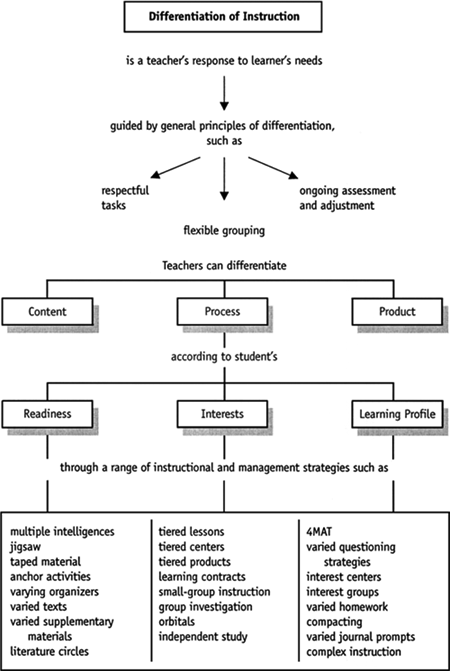
Learners also differ in their socioeconomic status (SES). Research shows that lower SES learners have lower and slower academic achievement as compared with students of higher SES. Teachers need to help overcome the stigma of poverty by viewing SES learners as an individual rather than as a member from low or high SES. By relating the content knowledge to daily life experiences and creating a worthwhile learning environment (less stress and more fun) learners can improve their achievement. Give more encouragement so they can have hope and adapt and focus in their learning amidst difficulty of life and guide them in making smart decisions in their life.
The mindmap below shows the hypothesized mechanisms by which SES operates to influence structural and functional brain development.

For teachers to successfully address the needs of diverse learners, we need to learn on how to be creative in our teaching so that learning would be more interesting. The following describes a creative teacher.
- Creative teachers are aware of and value the human attribute of creativity in themselves and seek to foster such a mindset in the young.
- Creative practice is multilayered; it encompasses the three dimensions, namely personal qualities, pedagogy (methods and practice of teaching) and ethos (distinguishing characteristics or guiding belief), each of which has a distinctly creative orientation.
- Creative teachers personally, pedagogically and in their classroom ethos, both demonstrate and develop children’s curiosity, their connection making, autonomy, ownership and originality.
- Creative teachers are autonomous professionals, who actively model their own creative engagement in the classroom and seek to nurture this in children.
- While all good teachers reward originality, creative ones depend on it to enhance their well-being and that of their pupils; they see the development of creativity and originality as the distinguishing mark of their teaching.
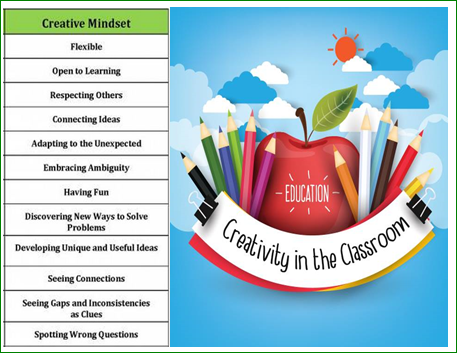
In order to develop and sustain creative state of mind, our flexibility, collaborative capacity, optimistic and creative disposition as an individual and as creative practitioner, we should seek to:
- prize a questioning stance and foster learners curiosity through offering them the chance to undertake their own enquiries;
- make personal and professional connections;
- exert our professional autonomy and co-construct the curriculum with the learners, thus increasing their ownership and autonomy;
- encourage, profile and celebrate originality in both ourselves and the learners;
- continue to read and reflect upon our growth as a creative professional and research our own and the learners creative learning within and beyond the classroom.
By being aware of the aspects of student diversity and ways on how to be creative in teaching we can appropriately address the need of these learners thus improving their performance in reaching the learning goals and help them develop their full potentials.
B. INSTRUCTIONAL PLANNING
Teachers are designers. They select or develop activities and information sources that will assist learners in teaching these goals.
Instructional Design describes the process involved in the systematic planning of instruction. It answers three major questions (Mager, 1984).
- Where are we going? Where we’re going.
- The goals of the instruction?
- How will we get there? How we’ll get there.
- Instructional strategy and the instructional medium
- How will we know when we have arrived? How we’ll know when we’re there
- What should our tests look like?
- How will we evaluate and revise the instructional materials
The instructional design process includes the activities of analysis, strategy development, evaluation and revision.
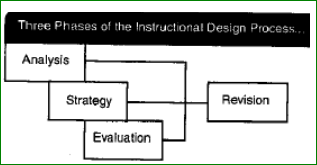
- Analysis: the designer analyse the learning task itself, asking what it must know or be able to do to learn.
- Strategy development: The designer determines the way that instructional material should be presented.
- Evaluation: The designer plans an approach for evaluating the instructional materials to determine what kinds of changes need to be made in them. We use the term assessment to evaluate students learning while we use the term evaluation to evaluate the instruction itself. Aspects involved in the assessment process often use the acronym VACSR: valid, authentic, current sufficient and reliable. Assessment should not be isolated from the teaching learning process it should be integral to it and continually takes place thought-out the time with the learners.
- Revision: the instructional design is revised as new information becomes available.
Although the instructional design process may often be portrayed as linear, in practice it is frequently iterative, moving back and forth between activities as the project develops.
The components of instruction: goals, learning activities, information sources and assessment tools, which are the products of the design process, should be congruent with each other.
Important guidelines to follow when planning instruction:
- Perform complete diagnostic assessments of learners’ needs and characteristics.
- Use diagnostic assessment information when planning.
- Do not rely entirely and uncritically on textbooks and their accompanying aids when planning.
- Include a combination of lower-level and higher-level expectations or learning outcomes.
- Include a wide range of instructional activities and strategies to fit learners’ instructional needs.
- Match educational expectations or learning outcomes with teaching strategies, activities, and planned assessments.
- Recognize one’s own knowledge and pedagogical limitations and planned preferences.
- Include assessment strategies in instructional plans.
Table 3.3 summarizes student, teacher, and instructional resources and considerations.
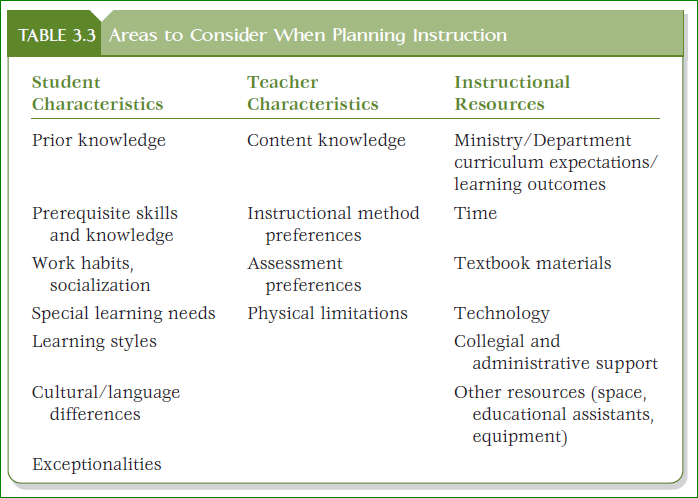
A final important resource that greatly influences teacher planning is time. Time is a limited resource that has important consequences for planning instruction. Each teacher’s decisions about what content to stress or omit is based in part on the instructional time available.
Bear in mind that in planning instruction we must first see the big picture of the course and be aware of the goals and objectives for the whole term before planning the weekly lesson. If the big picture is kept in mind, the individual lessons will connect to form a learning experience that benefits both the teacher and the learners.
Objectives are important in developing instructional plans.
Objectives must be SMART: specific, measurable, attainable, result–oriented and time-bounded to ensure greater match between instruction and assessment. It needs to be specific and must demonstrate knowledge, skills, values, attitudes and interest to allow teachers to evaluate the extent of which course objectives have to be met.
Three levels of abstraction represent degrees of objective specificity: global, educational and instructional (Krathwohl & Payne, 1971). Note that regardless of the type or specificity of an objective, its focus should always be on student learning and performance. Table 3.4 illustrates the difference in degree of breadth among the three types of objectives and compares their purposes, scopes, and time frames.

Thus, the level at which an objective is stated—global, educational, or instructional—has an impact on the manner in which processes such as planning, instructing, and assessing will be structured and carried out.
In addition to differing in terms of level, classroom objectives (and their related instruction and assessments) differ in terms of three general types of human behaviour: the cognitive, affective, and psychomotor domains. Classroom assessments cover cognitive, affective, and psychomotor behavior because teachers are interested in knowing about their students’ intellectual, attitudinal, and physical characteristics.
Bloom’s Taxonomy, or the Cognitive Taxonomy, is widely used by teachers to describe and state cognitive objectives. It consists of three taxonomies: (see table 3.5)

- Cognitive: or the knowledge-based objectives that deals with learning certain facts and concepts; relies on recall and recognition of knowledge and development of intellectual abilities and skills. Mental processes involve memorization and ability to think, analyse and solve problems. We need to aim at the development of critical and creative thinking by including questions that are high-level, divergent or open-ended. Teaching strategies and techniques must be a catalyst in the development of high-order thinking skills.
- Psychomotor: or the skills-based objectives that deals with learning ‘how to do something’
- Affective objectives or the development of attributes like feelings, values, attitudes and interests, preferences and commitment
These levels of expertise are listed in order of increasing complexity. Higher level of expertise needs more sophisticated classroom assessment technique. We need to choose which category corresponds to the course objectives. Then use the descriptions of different levels of expertise. Also, choose which description matters the measurable learners outcome.
C. ON CLASSROOM MANAGEMENT
Classroom management is an important phase in teaching. It includes operation and control activities. Such activities include seating arrangement, attendance, day to day classroom courtesies, and choice of instructional materials to use for a particular lesson.
No classroom activities can prosper effectively without the teacher doing his role as a classroom manager. Normally, the failure of the teaching-learning process is traced to the inability of the teacher to impose discipline when needed. In addition, teacher should concern himself with care of routine to facilitate learning. This includes setting the intellectual atmosphere that will be conducive to the learning process. No matter how much potential the teacher has if he is unable to control his students in the classroom, all activities will not be carried out efficiently. The wise use of the teacher and student’s time, effort and energy is reflective of a good classroom management.
Likewise classroom management also includes control of activities in the classroom. Management demands of the teacher the ability to impose discipline on students plan the needed appropriate activities for the day and have enough foresight about the possible outcomes in terms of the intended objectives. A good classroom atmosphere that accrues from an effective classroom management almost always makes learning an enjoyable and productive experience. There is no waste of time and energy for both teacher and students because of careful planning.
The following are ways on how we can effectively manage our classrooms:
Being Assertive: Teachers must be assertive between what and how much students are allowed to do in the classroom. It must be clear that students are responsible for their actions. This implies that as teacher being the authority in the classroom can handle discipline problems.
Behavior modifications: this motivates students to develop appropriate behavior through rules, reward, punishment or modelling Models serves as person to emulate copy and identify with themselves.
Valuing time: teachers must optimize time by concentrating on doing what is the most important.
Allowing students to participate in decision-making: Being successful in sharing the decision making process will give way to mistaken goal like attention getting, power seeking, revenge seeking and withdrawal.
- Teachers should guide students to make good choices by stressing their responsibilities for their own behavior, establishing rules, valuing right behavior and discouraging wrong behavior, suggesting suitable alternatives or bad behavior that will reinforce their responsiveness, being persistent, proactive and continually reviewing issues and solutions to the students.
Establishing Routines: By establishing routines for all daily tasks. Doyle says, routinization makes classroom activities less susceptible to breakdowns and interruptions because students know the normal sequence of events and what is expected of them (Ornstein, p. 96)
Kounin (1977) Withitness (being with it): As teachers we know what is going on in the classroom at all times; know who are working and who are not; know who need help and know how to carry out instruction while monitoring learners behavior. The use of withitness heightens the awareness of the needs of different types of learners ‘actions in the class.
The information mentioned above will be my guide as I continue my journey for an effective teaching experience.
The following are modifications that I did in my classroom to create a better physical learning environment.

Apparatus found in the cupboards and available when we’re going to do an experiment. Chairs and tables are portable for easy rearrangement depending on the need of an activity whether it is an independent study to collaborative activities.

Visualizer, computer and projector, speakers and visual aids are used to facilitate learning efficiency especially for visual learners.

A bulletin board with classroom rules to remind the class what behavior is necessary in the when learning. Also, students work are posted on it to motivate them to do better in class. Posting changes whenever a great work is created whether it is individual, pair or group work.
References:
(Zintel, Dawn). Designing Training for Multicultural Learners. Part Five: Learning Styles and Instructional Methodologies. Retrieved from http://www.trainingalliance.com/art-mult-learners5.html
Images source:





















